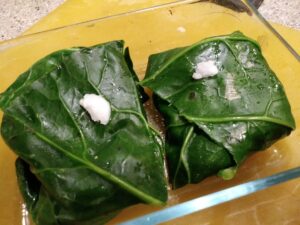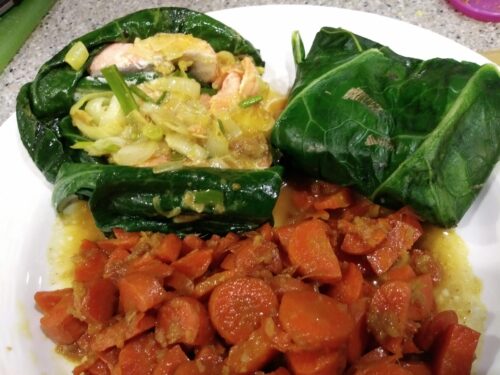You’ve heard that wild caught salmon is better than farm-raised, both for humans and the environment. For some people, however, wild-caught salmon can taste dry and tough because it doesn’t have the fat content of farm-raised salmon.
One solution: Cooking it “en papillote,” a fancy French term for cooking “in a paper packet,” which gently steams the salmon so it stays moist and tender. In this recipe, collard greens provide a beautiful–and super nutritious–replacement for the usual parchment paper.
Curried Salmon “en Collard-Leaf Papillote”
Serves 2
Step 1
- 1 Tbsp. + 1 tsp. coconut oil
- 1 cup green onions, white parts sliced 1/4″ thick, green parts sliced about 1/2″ thick
- 1/2 to 1 tsp. yellow curry powder, to taste
- 1 cup coconut milk (canned variety, not refrigerated milk alternative)
Preheat oven to 400(F). In a small skillet, warm the 1 Tbsp. oil over medium heat and sauté onion for just 4-5 minutes, stirring a couple times to avoid burning. Make a hole in middle of pan, add the 1 tsp oil and when warm, stir in curry powder. Cook a couple more minutes until fragrant, then add coconut milk and stir everything to combine well. Reduce heat to low and simmer, uncovered, about 5 minutes until coconut milk is reduced by a third to a half, stirring a couple times to avoid burning.
Step 2
- 2 large collard leaves
While onion mixture cooks, put about 1/2″ water in a large saucepan or small skillet with a lid. Bring to a boil over high heat.
Lay each collard leaf on cutting board and use a small paring knife to cut out the stem. (Reserve for another use.) Once water is boiling, drop in the leaves and gently submerge using a large spoon. Cover and cook just 2-3 minutes until limp. Use tongs to remove, gently shaking off water. Lay on cutting board or plate, overlapping the edges where stem was removed.
Step 3
- 1/2 lb. wild-caught salmon fillet
- Sea salt and freshly ground pepper
 While collard leaves cook, cut salmon into roughly 1″ x 2″ chunks. Place half of chunks on each leaf, skin side down, and sprinkle with salt and pepper to taste. Spoon half of cooked onion mixture over each salmon half. Fold sides and then ends of leaf over salmon, doing your best to make little “packets.”
While collard leaves cook, cut salmon into roughly 1″ x 2″ chunks. Place half of chunks on each leaf, skin side down, and sprinkle with salt and pepper to taste. Spoon half of cooked onion mixture over each salmon half. Fold sides and then ends of leaf over salmon, doing your best to make little “packets.”
Lightly oil a small baking dish with coconut oil. Carefully place packets in the dish. Bake about 10 minutes for salmon pieces that are 1/2″ thick. For thicker pieces, bake another 1-3 minutes.
Step 4
• Freshly squeezed lemon juice
Plate salmon packets, then slice open and serve with a squeeze of fresh lemon. Set the table with steak knives and forks so the packets can easily be cut open.
Preparation Note: Parchment Paper This recipe can also be made with parchment paper if you don’t have collard leaves. I like the unbleached variety.
Baking Note: The hard part about cooking fish en papillote is that it’s hard to test for doneness. I always have to open a packet and probe inside with a fork to make sure the fish is cooked through but not overdone. I find that salmon steamed en papilotte becomes pink throughout, unlike pan-fried or grilled salmon which I like best when it is still a little red inside.
Shopping Note: Sitka Salmon I’ve recently discovered a great outlet for wild-caught salmon–and a variety of other wild-caught fish: Sitka Salmon Shares. I have been impressed because even though the salmon is wild caught and frozen it still cooks up moist and tender–as long as you keep a close eye on it! No checking email while waiting for it to cook! And it is especially nice when cooked en papillote. Also, buying direct from Sitka supports small-boat fishermen who employ environmentally sustainable fishing methods; and the shipping packaging is totally recyclable with all your other cardboard.
On the Side–A Couple Ideas
• Roasted Cauliflower
• Corn with Roasted Red Pepper Bits
• Carrots (pictured, cooked in broth with ground cumin)
• Baked Sweet Potatoes
• Brown Basmati Rice


From Julie, one of our readers: “I made collard wrapped salmon tonight. Modified the salmon topping based on the ingredients I had on hand. The end result was delicious and a beautiful presentation! I’ll mark the recipe as an elegant dish to serve guests.”